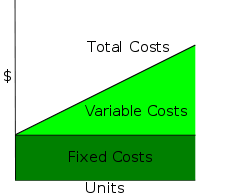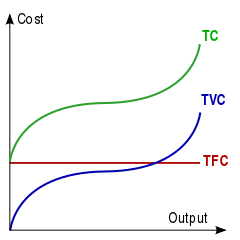Total cost
In economics, total cost (TC) is the total economic cost of production and is made up of variable cost, which varies according to the quantity of a good produced and includes inputs such as labour and raw materials, plus fixed cost, which is independent of the quantity of a good produced and includes inputs that cannot be varied in the short term: fixed costs such as buildings and machinery, including sunk costs if any.


Total cost in economics, unlike in cost accounting, includes the total opportunity cost (implicit cost) of each factor of production as part of its fixed or variable costs.
The rate at which total cost changes as the amount produced changes is called marginal cost. This is also known as the marginal unit variable cost.
The total cost of producing a specific level of output is the cost of all the factors of input used. Often, economists use models with two inputs: physical capital, with quantity X and labor, with quantity L. Capital is assumed to be the fixed input, meaning that the amount of capital used does not vary with the level of production in the short run. The rental price per unit of capital is denoted r. Thus, the total fixed cost equals Kr. Labor is the variable input, meaning that the amount of labor used varies with the level of output. In fact, in the short run, the only way to vary output is by varying the amount of the variable input. Labor usage is denoted L and the per unit cost, or wage rate, is denoted w, so the variable cost is Lw. Consequently, total cost is fixed cost (FC) plus variable cost (VC), or TC = FC + VC = Kr+Lw. In the long run, however, both capital usage and labor usage are variable.
Other economic models have the total variable cost curve (and therefore total cost curve) illustrate the concepts of increasing, and later diminishing, marginal return.
In marketing, it is necessary to know how total costs divide between variable and fixed. "This distinction is crucial in forecasting the earnings generated by various changes in unit sales and thus the financial impact of proposed marketing campaigns." In a survey of nearly 200 senior marketing managers, 60% responded that they found the "variable and fixed costs" metric very useful.[1]
Calculating cost
- Total product (= Output) = Quantity of goods
- Average Variable Cost (AVC) = Total Variable Cost / Quantity of goods (This formula is cyclic with the TVC one)
- Average Fixed Cost (AFC) = ATC – AVC
- Total Cost = (AVC + AFC) X Quantity of goods
- Total Variable Cost = Variable cost per unit X Quantity of goods
- Total Fixed Cost = TC – TVC
- Marginal Cost = Change in Total Costs / Change in Quantity of goods
- Marginal Product = Change in Quantity of goods / Change in Variable Factor
- Marginal Revenue = Change in Total Revenue / Change in Quantity of goods
- Average Product = Quantity of goods / Variable Factor
- Total Revenue = Price X Quantity of goods
- Average Revenue = TR / Quantity of goods
- Total Product = AP X Variable Factor
- Profit = TR – TC or (P-ATC)*Q
- Loss = TC – TR (if positive)
- Break Even Point: value of Quantity of goods where Average Revenue = Average Total Cost
- Profit Maximizing Condition: Marginal Revenue = Marginal Cost
- Marginal Revenue =The rate of change in Total Revenue with Quantity
References
- Farris, Paul W.; Neil T. Bendle; Phillip E. Pfeifer; David J. Reibstein (2010). Marketing Metrics: The Definitive Guide to Measuring Marketing Performance. Upper Saddle River, New Jersey: Pearson Education, Inc. ISBN 0-13-705829-2. The Marketing Accountability Standards Board (MASB) endorses the definitions, purposes, and constructs of classes of measures that appear in Marketing Metrics as part of its ongoing Common Language in Marketing Project.